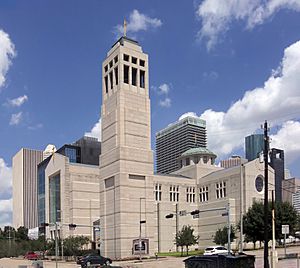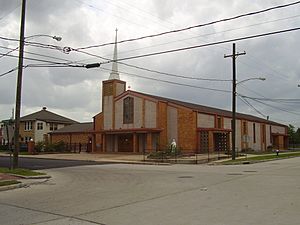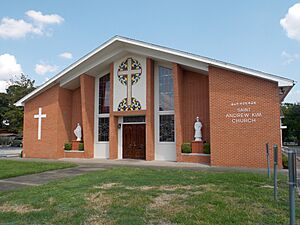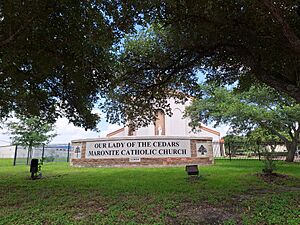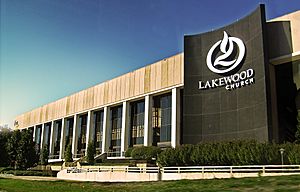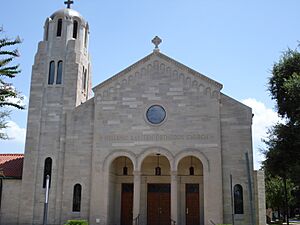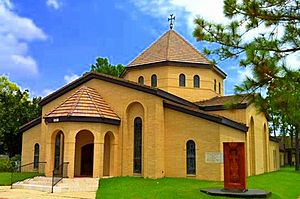Christianity in Houston facts for kids
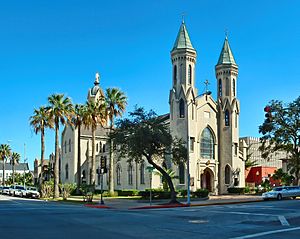
Christianity is the most common religion in Houston, Texas. In fact, in 2012, a newspaper called the Houston Chronicle said Houston was a "heavily Christian city." Many different Christian groups from various countries practice their faith here. Most Christians in Houston are either Catholic, Baptist, or belong to churches that are not tied to a specific larger group (non/interdenominational).
Lakewood Church in Houston is the biggest church in the United States! In 2010, about 44,800 people attended its services each week. This was a big jump from 11,000 weekly attendees in 2000. Outreach Magazine listed the 100 largest Christian churches in the U.S. in 2010. Several Houston-area churches were on that list, including Lakewood, Second Baptist Church Houston, Woodlands Church, Church Without Walls, and First Baptist Church. Houston and Dallas were even tied for the second most popular city for very large churches, often called megachurches.
Contents
Catholicism
The main Catholic area in Houston is called the Roman Catholic Archdiocese of Galveston-Houston. Its main office is in Downtown Houston. The original main church for this area is St. Mary Cathedral Basilica in Galveston. There's also a special co-cathedral, the Co-Cathedral of the Sacred Heart, located in Downtown Houston.
The very first Catholic church in Houston, St. Vincent's Church, opened its doors in 1839. A bishop named John Odin arrived in 1841 to help set it up. By the fall of 1842, the church building in the Second Ward was finished. In 1871, when a larger church called Annunciation Church opened, St. Vincent's became a church mainly for German Americans.
St. Nicholas was the city's first Catholic church for Black people, located in the Third Ward.
In 1910, there were no Catholic churches specifically for Mexican people in Houston. Some Mexican people were not allowed to attend English-speaking Catholic churches, and those who did often faced unfair treatment. In 1911, the Roman Catholic Diocese of Galveston brought in priests called Oblates of Mary Immaculate to help the Mexican community in Houston. In 1912, Our Lady of Guadalupe Catholic Church, the first Mexican Catholic church, opened. As more Catholic services were needed, these priests started missions in different Mexican-American neighborhoods. The Catholic Church created Our Lady of Guadalupe so that white people, who were used to separating races, would not be upset by Mexican people in their churches. The second Mexican Catholic church, Immaculate Heart of Mary Catholic Church, opened in the 1920s. It started as a small mission in Magnolia Park. A permanent building, paid for by the community, opened in 1926.
In the 1920s, some Louisiana Creole people went to the Hispanic Our Lady of Guadalupe Church because it was the closest church to their Frenchtown area in the Fifth Ward. However, the Our Lady of Guadalupe church treated the Creole people unfairly. They were made to confess and receive communion after people of other races and were forced to sit in the back pews. Because of this, the Creoles decided to build their own church. The Our Mother of Mercy Catholic Church in the Fifth Ward, which was Houston's second Catholic church for Black people, officially started in June 1929.
The number of Black Catholics in Houston grew after the Great Mississippi Flood of 1927 affected many rural areas in the southern United States. Many people moved to the Fifth Ward. In the 1930s, the Catholic Church in Houston became more popular with African-Americans because it was seen as more welcoming than some Protestant churches. St. Anne de Beaupre in Sunset Heights, the third Black Catholic church, opened in 1938. By 2012, this church even held services in Swahili for its African immigrant members. St. Nicholas also has a group of Cameroonians in its church, with special services each month for them.
In 1972, Catholic leaders and Hispanic members in Houston took part in a special meeting called Encuentro Hispano de Pastoral (Pastoral Congress for the Spanish-speaking). This event was a very important moment for Mexican American Catholics in Houston. They were trying to find their place not only among the white majority, but also with the large Black population and Mexican Protestant groups. St. Faustina Catholic Church, popular with Venezuelan people in the Greater Katy area, is near Cinco Ranch. It used to hold services at a school, but in 2017, it moved into its own large building that can seat 1,600 people. It has services in Spanish.
Many of the first Vietnamese immigrants to Houston, who arrived after the Vietnam War, were Catholic. By 1999, the Houston area had about 40,000 Filipino Catholics, 30,000 Vietnamese Catholics, 350 Chinese Catholic families, over 1,000 Korean Catholics, and about 500 Indian Catholics. Vietnamese Catholic churches in Houston include Christ Incarnate Word Parish, Holy Rosary Parish, Our Lady of Lavang, Our Lady of Lourdes, and Vietnamese Martyrs. In 1988, the Chinese Catholic church, Ascension Chinese Mission, opened. The Korean Catholic church, St. Andrew Kim Catholic Church, is in Spring Branch. There were no specific Filipino and Indian Catholic churches.
Houston also has a church for Polish American people, Our Lady of Czestochowa Roman Catholic Parish in Spring Branch. It was started in the 1980s when Polish immigrants, who were against Communist rule in their home country, came to Houston.
Maronite Catholics
As of 2008, Our Lady of the Cedars Maronite Catholic Church was Houston's only Maronite Church. This church is a part of the Catholic Church but has its own special traditions and ways of worship. In 2008, a church spokesperson said there were about 500 families who were members, and that the community had grown since the 1990s.
Protestantism
Anglicans and Episcopalians
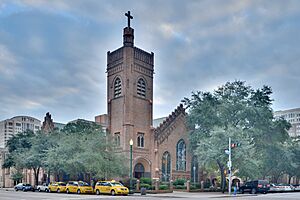
Anglican and Episcopalian churches are served by many groups. The Episcopal Diocese of Texas is the oldest group for this area. Other churches are part of the Anglican Diocese of the Western Gulf Coast.
Baptists
Baptists are a very large group in Houston, with many different types of Baptist churches. As of 2020, over 926,000 people in the Houston area belonged to Baptist churches. Some of the largest Baptist groups include the Southern Baptist Convention and the National Baptist Convention USA.
The oldest Baptist church in Houston that is mainly for African Americans is the Antioch Missionary Baptist Church. It was historically in the Fourth Ward and is now in Downtown Houston. Good Hope Missionary Baptist Church, another Black church, started in 1872.
As of 2012, Second Baptist Church Houston is the largest Baptist church in the U.S.
Lutherans
Lutheran churches in Houston are part of groups like the Texas-Louisiana Gulf Coast Synod of the Evangelical Lutheran Church in America and the Texas District of the Lutheran Church–Missouri Synod.
Methodists
Houston is part of the Texas Annual Conference of the United Methodist Church. Other Methodist groups, like the African Methodist Episcopal Church, also have a strong presence here.
As of 2001, Windsor Village United Methodist Church is the largest Methodist church in the U.S.
Non/interdenominational Churches
Non/interdenominational Christians are served by hundreds of churches. These churches are not officially tied to a larger group or denomination. Lakewood Church used to be Baptist, but now it identifies as non-denominational. Woodlands Church is also a non-denominational church.
As of 2008, the oldest Korean church in Houston is the Korean Christian Church of Houston.
Presbyterians
Presbyterian churches in Houston are part of groups like the Synod of the Sun of the Presbyterian Church USA. Some churches, like the First Presbyterian Church, have chosen to join other Presbyterian groups like ECO.
Houston's three largest Presbyterian churches, Grace Presbyterian, Memorial Drive Presbyterian, and First Presbyterian Church, are now part of ECO.
In 2001, the Korean Community Church opened in The Woodlands. It offers Presbyterian services in Korean and non-denominational services in English. It was created to serve Korean people in The Woodlands and nearby towns.
Church of Jesus Christ of Latter-day Saints
Members of the Church of Jesus Christ of Latter-day Saints, often called "Mormons," arrived in Houston by 1918. The first official group was formed in 1921, and their first meetinghouse was built in 1933. The first meetinghouse built by the church in Houston was on Calumet Street in Midtown Houston in 1941.
Today, there are 22 "Stakes" of the Church of Jesus Christ of Latter-day Saints in the Houston area. Stakes are groups of churches, similar to Catholic dioceses but smaller. Each stake usually has 6-12 local churches called "wards" or "branches."
The Church of Jesus Christ of Latter-day Saints in Houston has churches that speak English, Spanish, Chinese, Vietnamese, and American Sign Language (ASL). There are also groups for young single adults and for people who are in prison. One special building called a temple, the Houston Temple, is located near Houston. It is the second temple built in Texas and was dedicated on August 26, 2000.
In 2011, Kate Shellnut of the Houston Chronicle reported that the Church of Jesus Christ of Latter-day Saints was growing in the Houston area. As of 2016, church records showed about 50,000 members of the Church of Jesus Christ of Latter-day Saints in the Houston area.
Orthodoxy
As of 2011, Eastern Orthodox churches in Houston are growing in membership. Many immigrants from Eastern Europe, the Middle East, and other countries have joined Houston's Orthodox community. In 2013, Father John Whiteford, a pastor of St. Jonah Orthodox Church, estimated there were about 6,000-9,000 Eastern Orthodox Christians in Houston.
The largest Orthodox churches in Houston include Annunciation Cathedral Greek and St. George Antiochian. Orthodox churches often hold cultural festivals, like the Greek Festival.
The first Orthodox church in the Houston area, named after Saints Constantine and Helen, was in Galveston in 1861. People from Houston would take a train to Galveston to attend services. Immigrants from places like Greece, Russia, and Syria founded Orthodox churches in Southeast Texas starting in the early 1900s.
Armenians
St. Kevork Armenian Church, which started around 1982, is the Armenian Apostolic Church in Houston. As of 2007, about 10% of the estimated 4,000-5,000 Armenian people in Houston were active members of this church.
Coptics
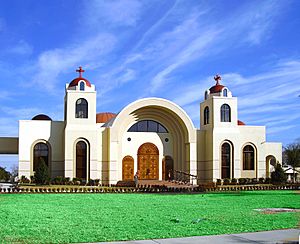
Houston is part of the Coptic Orthodox Diocese of the Southern United States.
As of 2004, there were three Coptic Orthodox churches in Houston: St. Mark Coptic Orthodox Church in Bellaire, the St. Mary and Archangel Michael Church in northwest Harris County, and the Archangel Raphael Coptic Orthodox Church in Clear Lake City. The St. Mary and Archangel Michael church started services in 2004 and had 200 families by August of that year. It is the largest Coptic church in the Houston area.
In the late 1960s, there were very few Coptic families. A priest from Los Angeles would fly to Houston every month to hold services in a borrowed church or a private home. From 1968 to 2006, over 600 Coptic families moved to Houston. The number of members in Coptic churches in Houston grew because of challenges faced by Copts in Egypt.
Ethiopians

Houston's Ethiopian Orthodox church is the Debre Selam Medhanealem Ethiopian Orthodox Tewahdo Church in Fondren Southwest. Its name roughly means "Sanctuary of Peace and the Savior."
Before this church was built, Ethiopian Orthodox followers worshiped at Coptic Orthodox churches. In 1992, 20 Ethiopian women who were attending a Coptic church planned to establish an Ethiopian church. In 1993, the group bought land and used a tent for church services. After raising money, construction of the permanent church began in 1995. In 2003, it was estimated that there were about 5,000 Ethiopians in Greater Houston.
Greeks
Houston is part of the Greek Orthodox Archdiocese of America, specifically the Metropolis of Denver.
Malankara Syrians
The Malankara Orthodox Diocese of Southwest America has its main office in Fort Bend County, Texas, near Beasley.
Russians
As of 2010, St. Jonah Orthodox Church, located in an area near Spring, is the only Russian Orthodox church in Houston that holds services in English. The church started holding services in 1998. As of 2010, about 90 people attend this church.
Another church, St. Vladimir's Russian Orthodox Church, holds services in an old Slavic language.
Indian Churches
In 2021, Fort Bend County had about 24 churches for people from India.
Religious leaders
- Kirbyjon Caldwell
- Daniel DiNardo
- Joseph Fiorenza
- Joel Osteen
- Jack Yates
- Homer Edwin Young
Prominent adherents
- Michael Arceneaux (author of I Can't Date Jesus, which talks about his past Catholic faith)
- Carol Vance (former District Attorney of Harris County)
Images for kids


